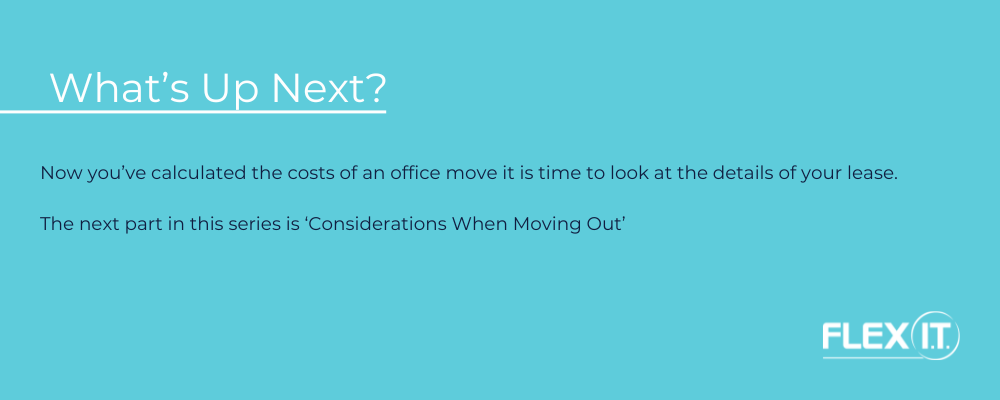Following on from our 5 Reasons to Relocate, we’re looking at the costs involved in moving office.
Moving office can be expensive, so it’s important to fully understand the cost involved and plan your budget ahead of time. Thinking back to your reasons for moving, there could be many financial benefits to relocating. In which case, consider the following as an investment rather than a cost.
There are five common types of costs associated with an office move:
- Removal costs
- Office fit-out costs
- Rates and charges
- Legal expenses
- Operational costs
Let’s look at each in more detail.
1. Removal costs
If you’ve ever moved house, you may have cut costs by ‘hiring a van’ or even loading up the car a few times. The task of dismantling, shifting and lifting, packaging and labelling, the loading takes hours. You’re exhausted, you realise you underestimated how much ‘stuff’ you have and you’ve still got to get to your new place and unload.
So, if you are tempted to save on the cost of removal by asking your staff to chip in with the packaging, loading, transporting and unloading, we’d suggest this is a false economy. Here are four points to consider:
- It makes more sense for the team to stick to their expertise and keep everything on track as much as possible. This approach will minimise disruptions and the impact on customers.
- A removal firm will have the necessary experience, equipment and technique to manage the process efficiently. They will speed things up and you don’t risk an employee being off work with a back injury.
- Many of the stresses involved in moving can be handled by the removal company. From packaging boxes to temporary storage facilities, there is less for you to manage.
- The removal company will be fully insured for the process. Therefore, if anything gets damaged or lost in transit, you are covered.
In summary, pay the professionals and get your business back up and running as quickly as possible.
How much should you budget for office removals?
The cost of removals depends on several factors including:
- Where in the country you are based & how far you are moving
- The volume and type of equipment being transported
- Whether anything needs to be stored
We recommend asking for three quotes to enable you to compare prices. In addition, the removals quote search site, getamover.co.uk provides a rough outline of what you might need to budget depending on office size.
2. Office fit-out costs
Few workspaces have the perfect layout for your needs, so the next cost to consider is how to kit out your new digs. As ever, the cost depends on some variables. The variables associated with estimating office fit-out cost are:
- The size of the space or the number of people working in the space
- The existing layout and whether partitioning is necessary
- The condition of the premises and if new wiring, fittings and other features are required
- The level of finish required
Office design company, Office Principles has created a cost calculator that helps you to work out a budget for your office fit-out.
Their advice is:
“As a guide for budgetary purposes, we suggest you add up the total number of staff and multiply by the figures we suggest below. This will provide you with a good indication of the likely fit-out costs that you would be looking at to redesign the interior of your office.
Basic range: allow £1000 – £1,500 per person
Mid-range: allow £1,500 to £2,500 per person
High range: allow £2,500 – £3,000 per person”
3. Rates and charges
We can forget about business rates. gov.uk says:
“You’ll probably have to pay business rates if you use a building or part of a building for non-domestic purposes.”
Business rates will be communicated by your local council and you’ll be billed every February or March for the financial year ahead. The gov.uk website provides a tool for estimating your business rates.
Another cost to consider is the service charge. Depending on the agreement in your new lease, you may be liable to regular payments that could be higher than your existing premises. Don’t let these costs surprise you, get them into your financial plans to budget for them.
4. Legal expenses
If you are renting a new office, you’ll need to sign a lease. It makes sense to have a legal expert browse the lease before you sign.
If you’re purchasing office space, you’ll certainly need to appoint a legal expert to navigate the process.
We’ll cover more about the legal considerations in the next two articles.
5. Operational costs
It’s nearly impossible to move offices without reducing productivity. The process might reduce operations over several days and this has a financial impact.
You can mitigate disruption to work during an office move by:
- Arranging laptops, portable Wi-Fi, cloud services and remote working options for employees. This is where Flex IT can assist, so Contact us today to find out more.
- Making use of business hubs, workshop hire and other temporary facilities
- Undertaking the move during off-peak times, such as over the weekend
- Organising a training event or client visits for staff, so time away from usual tasks is used effectively
Sometimes, work cannot continue without a physical work location, but with the steps above, you can maintain a level of normality in your service and reduce the financial impact of an office move.
If you are planning an office move and would like a copy of the complete Office Relocation series, or need support with handling the IT infrastructure we can assist. Contact us today to find out more.

